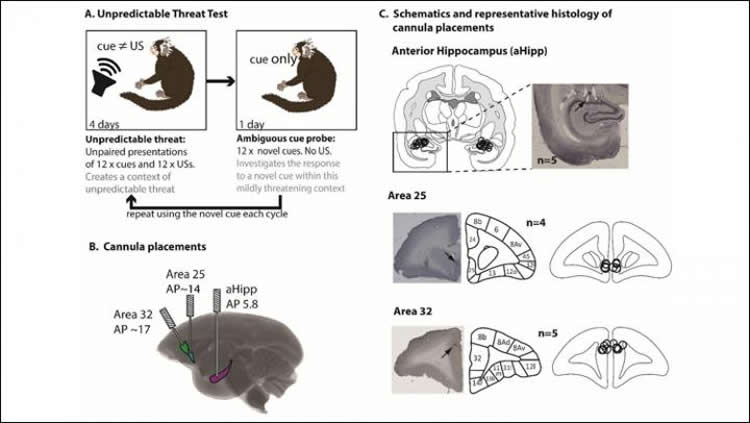Summary: Increasing glutamate levels in the hippocampus helps to reduce anxiety in monkeys, a new study reports.
Source: SfN.
Researchers studying male and female marmosets have homed in on the primate brain circuitry responsible for individual differences in overall anxiety. Their findings, published in Journal of Neuroscience, show that increasing levels of the neurotransmitter glutamate in the hippocampus normalizes anxious monkeys’ “fight or flight” response.
Previous human and animal studies suggest roles for glutamate, the hippocampus, and two prefrontal brain regions — known as area 25 and area 32 — in the behavioral and physiological response to threat. However, the contribution and interaction of these neural components in highly anxious primates is unclear.
Hannah Clarke and colleagues were able to make anxious monkeys more comfortable with an unfamiliar human, who wore different masks to conceal his or her identity, by increasing glutamate release in the anterior hippocampus. In response to an unexpected loud sound, increased hippocampal glutamate was associated with increased blood pressure, heart rate, and scanning of the environment — all of which are part of a typical threat response and reduced in anxious individuals.

These effects depended on functioning of area 25, implicating this brain region and its connection to the hippocampus as a promising target for reducing anxiety.
Funding: The research was funded by the Medical Research Council, Wellcome Trust, CNPq, Malaysian Public Service Department.
Source: David Barnstone – SfN
Publisher: Organized by NeuroscienceNews.com.
Image Source: NeuroscienceNews.com image is credited to Zeredo et al., JNeurosci (2019).
Original Research: Abstract for “Glutamate within the marmoset anterior hippocampus interacts with area 25 to regulate the behavioral and cardiovascular correlates of high-trait anxiety” by Jorge L. Zeredo, Shaun K. L. Quah, Chloe U. Wallis, Laith Alexander, Gemma J. Cockcroft, Andrea M. Santangelo, Jing Xia, Yoshiro Shiba, Jeffrey W. Dalley, Rudolf N. Cardinal, Angela C. Roberts and Hannah F. Clarke in Journal of Neuroscience. Published February 4 2019.
doi:10.1523/JNEUROSCI.2451-18.2018
[cbtabs][cbtab title=”MLA”]SfN”Boosting Glutamate Reduces Anxiety in Monkeys.” NeuroscienceNews. NeuroscienceNews, 4 February 2019.
<https://neurosciencenews.com/glutamate-anxiety-10684/>.[/cbtab][cbtab title=”APA”]SfN(2019, February 4). Boosting Glutamate Reduces Anxiety in Monkeys. NeuroscienceNews. Retrieved February 4, 2019 from https://neurosciencenews.com/glutamate-anxiety-10684/[/cbtab][cbtab title=”Chicago”]SfN”Boosting Glutamate Reduces Anxiety in Monkeys.” https://neurosciencenews.com/glutamate-anxiety-10684/ (accessed February 4, 2019).[/cbtab][/cbtabs]
Abstract
Glutamate within the marmoset anterior hippocampus interacts with area 25 to regulate the behavioral and cardiovascular correlates of high-trait anxiety
High-trait anxiety is a risk factor for the development of affective disorders and has been associated with decreased cardiovascular and behavioral responsivity to acute stressors in humans that may increase the risk of developing cardiovascular disease. Although human neuroimaging studies of high-trait anxiety reveals dysregulation in primate cingulate areas 25 and 32 and the anterior hippocampus (aHipp), and rodent studies reveal the importance of aHipp glutamatergic hypofunction, the causal involvement of aHipp glutamate and its interaction with these areas in the primate brain is unknown. Accordingly, we correlated marmoset trait anxiety scores to their post-mortem aHipp glutamate levels, and showed that low glutamate in the right aHipp is associated with high trait anxiety in marmosets. Moreover, pharmacologically increasing aHipp glutamate reduced anxiety levels in high anxious marmosets in two uncertainty based tests of anxiety — exposure to a human intruder with uncertain intent, and unpredictable loud noise. In the human intruder test, increasing aHipp glutamate decreased anxiety by increasing approach to the intruder. In the unpredictable threat test, animals showed blunted behavioral and cardiovascular responsivity after control infusions, which was normalized by increasing aHipp glutamate. However, this aHipp-mediated anxiolytic effect was blocked by simultaneous pharmacological inactivation of area 25, but not 32 — areas which when inactivated independently reduced, and had no effect on anxiety, respectively. These findings provide causal evidence in male and female primates that aHipp glutamatergic hypofunction, and its regulation by area 25, contributes to the behavioral and cardiovascular symptoms of endogenous high-trait anxiety.
SIGNIFICANCE STATEMENT
High-trait anxiety predisposes sufferers to the development of anxiety and depression. Although neuroimaging of these disorders and rodent modelling implicate dysregulation in hippocampal glutamate and the subgenual/perigenual cingulate cortices (areas 25/32), the causal involvement of these structures in endogenous high-trait anxiety, and their interaction, is unknown. Here we demonstrate that increased trait anxiety in marmoset monkeys correlates with reduced hippocampal glutamate, and that increasing hippocampal glutamate release in high-trait anxious monkeys normalizes the aberrant behavioral and cardiovascular responsivity to potential threats. This normalisation was blocked by simultaneous inactivation of area 25, but not area 32. These findings provide casual evidence in primates that hippocampal glutamatergic hypofunction regulates endogenous high-trait anxiety, and the hippocampal-area 25 circuit is a potential therapeutic target.






